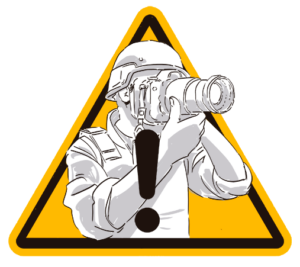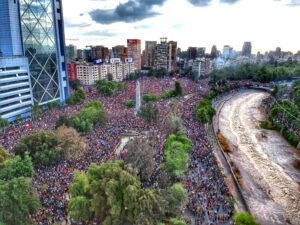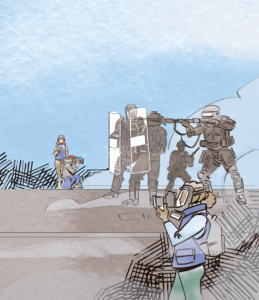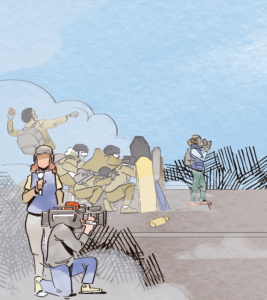This is the first story in a series on covering protests in Latin America. Here, read the second and third.*
This story has been updated.**

(Illustration: Pablo Pérez "Altais")
Ángel Gahona was broadcasting a confrontation between riot police and demonstrators via Facebook Live in Bluefields, Nicaragua when he was shot and killed.
Just four days earlier, on April 18, 2018, protests had broken out across the Central American country against pension reforms proposed by the regime of President Daniel Ortega.
Gahona’s case may have been unique because his killing was broadcast live. However, he was just one among many journalists victimized while reporting on street protests throughout Latin America in recent years.
The spike of public protests that sometimes turned violent requires guarantees from the State, but also preparation by Latin American journalists who find themselves in the midst of confrontations. Whether reporting on a demonstration against political corruption or rises in bus fare or illegal logging, preparing for these kinds of assignments can involve not only research into the people and issues involved, but also how to protect oneself from potential violence.
“[Preparation] makes it possible for someone to mentally prepare for and imagine themselves in possible scenarios,” Alejandra González, Article 19 Mexico consultant for attention to victims of serious human rights violations, told LatAm Journalism Review (LJR). "I see worse impacts in those who are not prepared, in those who do not envision themselves in a particular context, in those who do not know what to expect as opposed to those who do have a notion, who position their work in a conflict scenario.”
Growing protests in Latin America
“Globally, there is an increasing use of protest as a form of political participation,” V. Ximena Velasco Guachalla, assistant professor in the Department of Government at the University of Essex who specializes in studying protest, told LJR. “Citizens across the world are using protest not only more often, but are also using this form of political engagement to make more and varied demands to governments.”

Protestors in Plaza Baquedano in Santiago, Chile in 2019 (Hugo Morales, CC BY-SA 4.0 <https://creativecommons.org/licenses/by-sa/4.0>, via Wikimedia Commons)
The political, economic and social contexts of each country shape protest demands, according to the professor.
“The wave of protests across [Latin America and the Caribbean], that for several countries initiated in 2019, is motivated by several factors including corruption, increased taxes, food shortages, human rights violations, and elections among other demands,” Velasco Guachalla said. “While the motivations that engender protests have varied, one common denominator across the region has been the rejection of government repression once the demonstrations began.”
Velasco Guachalla added that, while these protests were happening before the pandemic, COVID-19 “exposed the shortcomings of governments in the region in terms of public service provision in times of crisis.” This led to new demonstrations.
In a region “known for social mobilization,” as the professor pointed out, the recent wave of protests are part of a long history. But in other countries, they are new.
“On one hand, protests in Bolivia, Argentina, Nicaragua, and Peru are part of a pattern of social mobilization with rich history in these countries,” she said. “On the other, Colombia and Chile are not characterized by massive mobilizations, and the recent events in these countries offer learning opportunities for old and emerging social movements.”
Attacks on journalists during protests
At least 12 journalists died during protests in Latin America and the Caribbean in the last 29 years, according to figures from the Committee to Protect Journalists (CPJ). In a majority of cases, the suspected aggressors are security forces or government actors.
The most recent killing of a journalist during protests in the region involved Chilean Francisca Sandoval who was shot in the face while covering Workers' Day demonstrations in Santiago on May 1, 2022. She died 12 days later, becoming the first journalist to be killed in the country in the scope of her work since Pinochet's rule.
Finding reliable information about the status of judicial investigations into killings of journalists during protests is a difficult task. However, out of the 12 cases, LJR research shows that only two have resulted in convictions that were upheld. Additionally, the trial for Ángel Gahona’s murder in southeast Nicaragua was criticized by many and the teenagers convicted were later granted amnesty.
Click the arrow on this interactive map to read about the cases of journalists killed during protests in Latin America since 1992, according to data from the Committee to Protect Journalists (CPJ).
In addition to the number of those who have been killed are the likely hundreds of journalists attacked, and some injured, threatened and harassed while covering protests in the region.
In a 2020 report, UNESCO found 125 instances of attacks on or arrests of journalists covering protests in 65 countries from 2015 to 2020. It marked a global spike in those figures in 2019.
“The notion of free expression is under siege in different nations around the world, primarily by governments who are not recognizing the right of the people to peacefully protest and the right of journalists to be present to cover those protests,” Frank Smyth, author of the report and global journalist security expert, told LJR.
Attacks on journalists covering protests have included harassment, beatings, intimidation, arrests, abductions, detentions, being shot with lethal and non-lethal ammunition, having equipment damaged, and more, according to UNESCO.
Further, most of the attacks globally have come from police and security forces, it added. There is no reliable data on the regional scale, but journalists can face attacks by both protestors and security forces.
In cases where violence comes from the State, Smyth said attacks on journalists in Latin America span regimes of different political ideologies.
“It’s excessive use of force as a way of controlling dissent, trying to suppress dissent and then trying to suppress the messengers that are reporting on those protests,” he said.
The responsibilities of the State
The Inter-American Commission on Human Rights (IACHR) of the Organization of American States (OAS), as well as the Inter-American Court of Human Rights (I/A Court), have made statements on the State’s responsibilities to protect journalists who cover protests as part of the guarantee of freedom of expression. They have also expressed the obligation of the States to investigate and punish the violations that occur during the coverage of protests.

(Illustration: Pablo Pérez "Altais")
“It should be especially borne in mind that it is the job of journalists, film crews, photojournalists, and media workers covering protests to gather and disseminate information on what happens in demonstrations and protests, including the actions of security forces; freedom of expression protects the right to record and disseminate any incident,” reads a 2019 report from the Special Rapporteur for Freedom of Expression of the IACHR.
“Journalists should not be detained for their work, or harassed or attacked by law enforcement,” it continues. “On the contrary, the State has a duty to protect them when they are the victims of acts of violence by third parties. Their equipment and materials cannot be retained, confiscated or destroyed.”
The Special Rapporteur also says authorities must condemn attacks against media workers and encourage investigation and prosecution by authorities.
“Although the State should generally refrain from using force in public demonstrations, it should formulate specific policies to prevent, investigate, and punish violence against journalists, media workers” and others because of their role “in the prevention, monitoring and oversight of State action,” it later states.
The I/A Court has even established jurisprudence for the States of the region. In a 2012 decision, it determined that Colombia had violated, among others, Article 13 of the American Convention on Human Rights – related to freedom of expression – after members of the country's Army attacked and threatened a journalist who was covering a demonstration against the government.
The Court's decision in the case of Vélez Restrepo vs. Colombia marks a milestone because it presents the guarantees that journalistic work must have during the coverage of protests as well as the duty of States to protect them.
“The sentence establishes several approaches that are relevant. The first is that State attention to protests is a matter of public interest and therefore there must be guarantees so that the press can cover these protest events,” Pedro Vaca, Special Rapporteur for Freedom of Expression of the IACHR, told LJR. "The second is that within the framework of these guarantees, the duty of prevention of violence against journalists who are reporting, protection of journalists who may be affected and investigation and punishment in the event that attacks against the press occur during reporting, apply.”
Because in the case of Richard Vélez there was not only aggression during the coverage of the protests in retaliation for recording the repressive acts of the Army against the protesters, according to Vaca, but also another series of violence (including threats) in the search for justice for Vélez, the Court was also able to establish protocols in that area.
“As of the second part of the Richard Vélez case, the States are obliged that, if journalists report attacks against them, the fact of denouncing does not imply violence or additional risks. And that undoubtedly marks a very important precedent for guarantees of freedom of expression in the region,” Vaca added.
Likewise, as part of the measures of reparation and guarantee that it not be repeated, the Court determined that Colombia should initiate training for members of security forces regarding the right to freedom of expression in order to make them more aware of the work of the media and journalists, and of their duty to protect that right.
Although this sentence of the Court has to do with the Colombian State, the truth is that its sentences in general become inter-American standards that other States of the region are also called upon to abide by.
“The sentences of the Inter-American Court also have that quality of becoming an inter-American frame of reference and standard. And when we speak of violence against journalists in the framework of the coverage of protests, we find that it is a challenge that several States of the region need to face. It’s especially desirable for them to set up prevention mechanisms. The security forces should be trained on the scope, characteristics and importance of journalistic work during press coverage so that they can be more aware of the operational scope,” the Rapporteur said. "And above all, I would argue that the security forces, far from attacking the press, are called to guarantee journalistic coverage."
Smyth also emphasizes the importance of training for security forces.
“The most important thing the state can do is [to give security forces] proper training, guidance and parameters that they cannot use excessive force against the press, to respect the fact that the press has the right to be present to cover demonstrations,” Smyth said. “It’s partly training, but it’s also making it clear that the right to protest is guaranteed, as is the right to cover those protests.”
“And we need leadership from governments across the continent to step up and affirm those norms and rights for free expression,” added Smyth, who is also the author of the Journalist Security Guide from the Committee to Protect Journalists (CPJ).
Necessary preparation
Despite these obligations on the part of the State, and without freeing it from responsibility, security experts point out that it’s necessary for both media outlets and journalists to take protection measures before going into the streets.

(Illustration: Pablo Pérez "Altais")
According to experts consulted by LJR, it is important that journalists receive both physical protection and reaction training to face these moments, but also psychological support.
According to Jeff Belzil, director of security for the International Women’s Media Foundation (IWMF) who has worked with journalists and media outlets in Latin America and the Caribbean, it seems that experience is what leads journalists to change attitudes and behaviors. And that’s why it is only until there is a “trauma” that journalists come to protests more prepared.
“Humans, we react to situations. It is like a child who will touch the stove and will touch it until it burns. And then when it burns, he learns that touching the stove with his hands is not the best idea in the world,” Belzil told LJR. “And the same thing happens with journalism, when anyone who hasn’t been in a situation [of being injured], during a protest, or they haven’t had any concrete experiences, they’re not going to prepare ahead of time. Those who suffered or had trauma, who suffered in an event, during a protest, well, next time they say 'I will never find myself in this situation without being prepared.’”
Journalists preparing to cover protests and demonstrations can undergo evasion, hostile environment and first aid training ahead of time. They should also learn which types of protective equipment are helpful, and which could potentially be hurtful. There are also measures in the digital realm, like protecting your devices and creating a communication network in case of emergency.
Physical safety and protection isn’t the only concern for journalists going to the streets. An often overlooked aspect of preparation and care after the fact involves what’s going on in journalists’ heads.
Luisa Ortiz Pérez, executive director and co-founder of Vita-Activa.org, created a helpline that offers psychological first aid to Latin American journalists and activists, particularly women or members of the LGBTQI+ community. She told LJR that, on average, her team receives calls on a daily basis from journalists covering protests or social and civil unrest.
“Psychological First Aid is the cornerstone toward generating a change of culture and more effective support systems for journalists and media professionals,” she said. “De-stigmatizing conversations about mental health, normalizing processes where we ask for help, integrating wellness, empathic, anti racist, gender conscious practices in our newsrooms equips journalists with the resilient skills needed to work in today's ever changing environment.”
The responsibilities of media and editors are also highlighted by the experts. For Belzil, for example, there are several steps that a media outlet could take, such as giving journalists the time and resources for training, delivering personal protective equipment, and making an evacuation and security plan, among other provisions.
In particular, Belzil highlights the need for journalists to know that it is okay to ask for help and that they should not take unnecessary risks.
“I would like editors to talk about safety with journalists. I would like them to talk about the limits, if things get ugly that you have no problem leaving the place,” Belzil said. “I would like to see that more: the media talking about the risks associated with the story and having a talk to say 'hey, I don't want you to put yourself in danger or get hurt' or 'nothing will happen if you leave or ask for help.”
For Belzil, these types of conversations are especially important for women journalists who, on account of “the issue of machismo” that affects them in different scenarios, put themselves at greater risk.
In the coming articles as part of this series, LJR will explore in further detail the problem of violence against journalists in the region who are covering protests and demonstrations, with examination of particular case studies. Then, we’ll pass on tips and recommendations from training experts to use when journalists go into the field.
Silvia Higuera and Júlio Lubianco assisted in reporting this story.
*This is the first article in a series on journalist safety in Latin America and the Caribbean. This LatAm Journalism Review project is funded by UNESCO's Global Media Defense Fund.
**This story was updated to include the killing of Chilean journalist Francisca Sandoval who was shot while covering May 1 Workers' Day marches in Santiago.
Read the rest of the articles in this project at this link.
